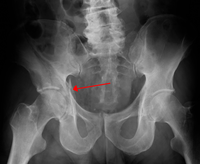
Photo from wikipedia
BackgroundFractures of the acetabulum in younger patients are commonly treated by open reduction and internal fixation. For elderly patients, stable primary total hip arthroplasty with the advantage of immediate postoperative… Click to show full abstract
BackgroundFractures of the acetabulum in younger patients are commonly treated by open reduction and internal fixation. For elderly patients, stable primary total hip arthroplasty with the advantage of immediate postoperative mobilization might be the adequate treatment. For this purpose, a sufficiently stable fixation of the acetabular component is required.Materials and MethodsBetween August 2009 and 2014, 30 cases were reported in which all patients underwent total hip arthroplasty additionally to a customized implant designed as an antiprotrusion cage. Inclusion criteria were an acetabular fracture with or without a previous hemiarthroplasty, age above 65 years, and pre-injury mobility dependent on a walking frame at the most. The median age was 79.9 years (65–92), and of 30 fractures, 25 were primary acetabular fractures (83%), four periprosthetic acetabular fractures (14%), and one non-union after a failed ORIF (3%).ResultsThe average time from injury to surgery was 9.4 days (3–23) and 295 days for the non-union case. Mean time of surgery was 154.4 min (range 100 to 303). In 21 cases (70%), mobilization with full weight bearing was possible within the first 10 days. Six patients died before the follow-up examination 3 and 6 months after surgery, while 24 patients underwent radiologic examination showing consolidated fractures in bi-plane radiographs. In 9 patients, additional CT scan was performed which confirmed the radiographical results. 13 had regained their pre-injury level of mobility including the non-union case. Only one patient did not regain independent mobility. Four complications were recognized with necessary surgical revision (one prosthetic head dislocation, one pelvic cement leakage, one femoral shaft fracture, and one infected hematoma).ConclusionThe presented cage provides the possibility of early mobilization with full weight bearing which represents a valuable addition to the treatment spectrum in this challenging patient group.
Journal Title: Archives of Orthopaedic and Trauma Surgery
Year Published: 2017
Link to full text (if available)
Share on Social Media: Sign Up to like & get
recommendations!